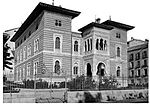Paseo del Prado
Art gallery districtsBien de Interés Cultural landmarks in MadridMuseo del PradoPaseo del PradoStreets in Madrid

The Paseo del Prado is one of the main boulevards in Madrid, Spain. It runs north–south between the Plaza de Cibeles and the Plaza del Emperador Carlos V (also known as Plaza de Atocha), with the Plaza de Cánovas del Castillo (the location of the Fuente de Neptuno, and of the Ritz and Palace five-star hotels) lying approximately in the middle. The Paseo del Prado forms the southern end of the city's central axis (which continues to the north of Cibeles as the Paseo de Recoletos, and further north as the Paseo de la Castellana). It enjoys the status of Bien de Interés Cultural (BIC), and as part of a combined UNESCO World Heritage Site with Buen Retiro Park.
Excerpt from the Wikipedia article Paseo del Prado (License: CC BY-SA 3.0, Authors, Images).Paseo del Prado
Paseo del Prado, Madrid
Geographical coordinates (GPS) Address Nearby Places Show on map
Geographical coordinates (GPS)
| Latitude | Longitude |
|---|---|
| N 40.414061 ° | E -3.693688 ° |
Address
Cafetería Prado
Paseo del Prado
28014 Madrid (Centro)
Community of Madrid, Spain
Open on Google Maps











